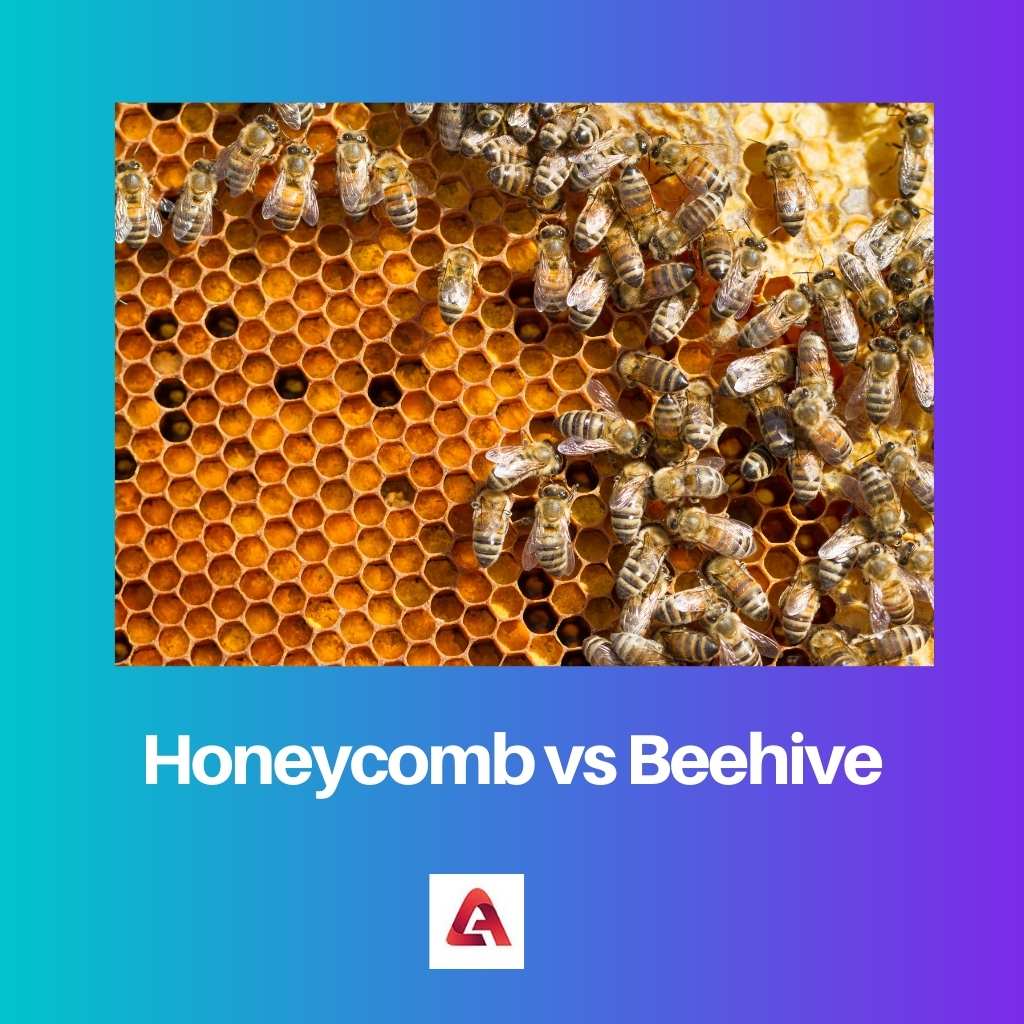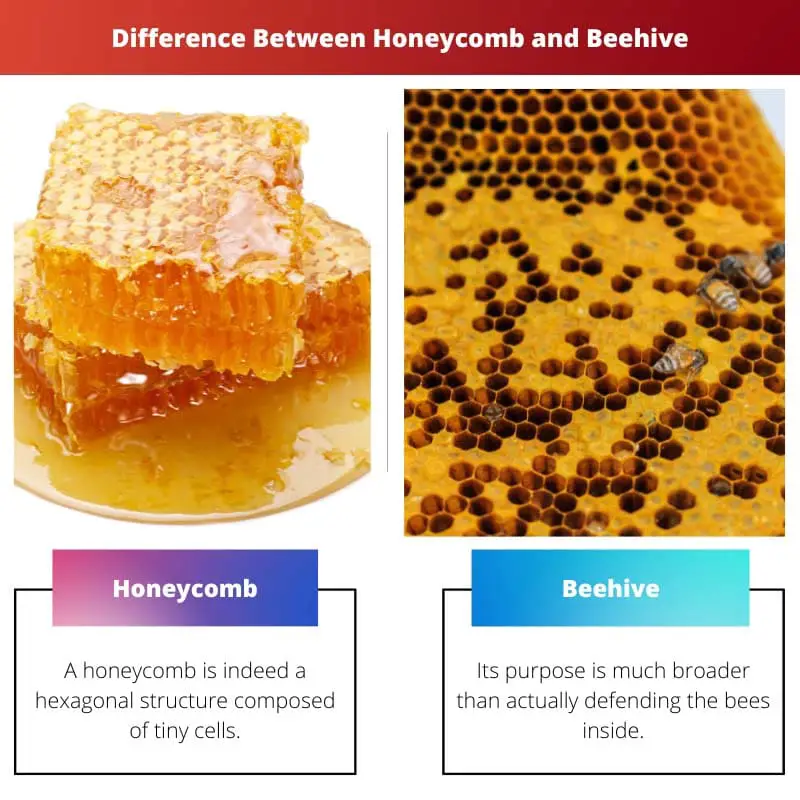A beehive is a man-made framework in which honey bees dwell and raise their young.
Though the term “beehive” is frequently used to refer to any bee colony’s nest, scientific and professional literature separates honeycomb from the beehive.
Both the beehive and the honeycomb serve multiple purposes, such as honey production and pollination.
Key Takeaways
- Honeycomb is a hexagonal structure made by bees to store honey, while a beehive is a structure that houses a colony of bees.
- Honeycomb is made of beeswax, while a beehive can be made of various materials like wood, plastic, or clay.
- Honeycomb is harvested for its honey, while beehive houses and protects bees.
Honeycomb vs Beehive
Honeycomb is a wax structure made by bees inside the beehive to store honey, pollen, and to raise their young. Honeycomb is a series of hexagonal cells made of beeswax. A beehive is a structure made by bees. It contains the honeycomb where they raise their young, and provide shelter to the colony.

A honeycomb is indeed a hexagonal structure composed of tiny cells. Those cells are 5 centimeters thick and can hold up to 25 times their weight.
The honeycomb reflects the tremendous organization that exists within the hive because, given the increasing number of bees that can be found inside, the hive’s order is nevertheless highly rigid.
Its purpose is much broader than actually defending the bees inside. The honeycomb has numerous purposes, as it not only stores honey but also performs as a nest for the young even as a heat barrier during the cold season.
The beehive is where all the bees live, and where the whole colony of bees resides. Up to 80,000 bees, including the queen bee, workers, and drones, can dwell in it.
The reality is that every other hive has a distinct odor that helps to identify its members. As a result, a hive is composed of variously built combs.
Inside the hive, there is a rigorous order that causes the bees to feel bewildered and sometimes even change their behavior if it is disrupted.
Comparison Table
| Parameters of Comparison | Honeycomb | Beehive |
| Definition | Hexagonal structures where some bee species live. | Any structure that provided habitation to bees. |
| Noun | Hexagonal framework | Any workplace where people are busy |
| Verb | Riddling something with holes, in a honeycomb pattern. | Filling a place with busy activities |
| Hairstyle | It’s not a hairstyle | Beehive was also a hairstyle of women popular around the 1960s. |
| Composition | Mainly made up of wax | Other materials are also used for Beehives |
What is Honeycomb?
A honeycomb is a collection of hexagon prismatic wax cells formed by honey bees inside their nests to hold their larvae and honey and pollen reserves.
To gather honey, beekeepers can remove the entire honeycomb.
Honey bees need 8.4 pounds of honey to produce 1 pound of wax, thus beekeepers can restore the wax towards the hive following harvesting its honey to boost honey yields.
When honey is removed from a comb by uncapping & spinning it in a spinning machine, more precisely a honey extractor, the comb’s structure can be left largely intact.
If somehow the honeycomb is just too worn out to use, the wax can be recycled in a variety of ways, including producing hexagonal comb foundation sheets.
The hexagonal layout of the base of the worker-sized cell inhibits the bees from developing the bigger drone cells, allowing the bees to construct the combs with less effort.
A new, fresh comb is sold and used whole as comb honey, particularly if indeed the honey is spread on toast rather than cooked with or used as a sweetener.
Brood comb darkens over time when unfilled cocoons & shed larval skins become stuck in the cells, as well as being repeatedly walked over by the other bees,
culminating in what beekeepers refer to as a ‘journey stain’ when visible on the frame of comb honey.
The honeycomb inside the “supers” that aren’t used for brood remains bright.

What is Beehive?
A beehive is indeed an enclosed building in which some Apis subgenus honey bee species dwell and rear their young.
Even though the term “beehive” is used to refer to any bee colony’s nest, scientific & professional literature distinguishes between the two.
The term “nest” refers to colonies that live in natural or manmade cavities, or that are suspended and exposed.
The term “hive” refers to a man-made structure that houses a honey bee nest.
Several Apis species live in colonies, however, the western honey bee, as well as the east honey bee, are the most common species maintained in hives for honey production.
The honeycomb, a densely packed set of hexagon prismatic cells composed of beeswax, is the nest’s internal structure. The cells are used by the bees to keep food (honey & pollen) as well as to house their offspring.
Honey production, pollinating of surrounding crops, supply of housing bees for apitherapy therapy, and attempting to offset the consequences of colony collapse are all reasons why beehives are used.
Hives are frequently transported in the United States so that honeybees can pollinate in different places. A variety of patents for beehive designs have been granted.

Main Differences Between Honeycomb and Beehive
- Honeycombs are hexagonal structures where bees live and raise their young ones, whereas the beehives could be of any shape and size.
- As a noun, honeycomb has a meaning of hexagonal framework whereas beehive refers to a busy workplace.
- As a verb, Honeycomb has a meaning of riddling something with holes in honeycomb pattern whereas beehive has a meaning of filling a place with some work.
- Beehive was a famous hairstyle among women in the 1960s whereas honeycomb isn’t a hairstyle.
- Honeycombs are mainly made-up of wax whereas beehives are composed of many things as they are mostly man-made.

- https://link.springer.com/article/10.1023/A:1010719107006
- https://link.springer.com/article/10.1007/s13592-020-00807-9
